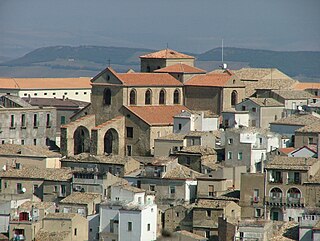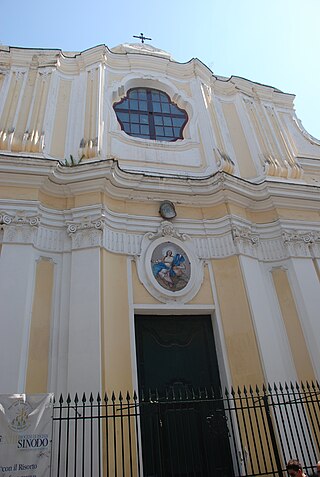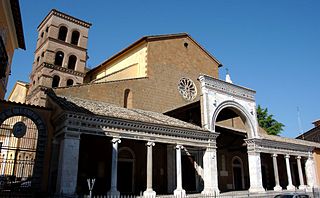
The Archdiocese of Amalfi-Cava de' Tirreni is an archdiocese of the Latin Church of the Catholic Church, with its episcopal see at Amalfi, not far from Naples. It was named Archdiocese of Amalfi until parts of the Diocese of Cava e Sarno were merged with it on September 30, 1986.

The Diocese of Tricarico is a Latin diocese of the Catholic Church in Basilicata. It is a suffragan of the Archdiocese of Potenza-Muro Lucano-Marsico Nuovo.

The Diocese of Cassano all'Jonio is a Latin diocese of the Catholic Church in Calabria.

The Diocese of Frascati is a Latin suburbicarian see of the Diocese of Rome and a diocese of the Catholic Church in Italy, based at Frascati, near Rome. The bishop of Frascati is a Cardinal Bishop; from the Latin name of the area, the bishop has also been called Bishop of Tusculum. Tusculum was destroyed in 1191. The bishopric moved from Tusculum to Frascati, a nearby town which is first mentioned in the pontificate of Pope Leo IV. Until 1962, the Cardinal-Bishop was concurrently the diocesan bishop of the see. Pope John XXIII removed the Cardinal Bishops from any actual responsibility in their suburbicarian dioceses and made the title purely honorific.

Matteo Orsini was an Italian Dominican friar and Cardinal.

The Diocese of Padua is a Latin diocese of the Catholic Church in Veneto, northern Italy. It was erected in the 3rd century. The diocese of Padua was originally a suffragan (subordinate) of the Patriarchate of Aquileia. When the Patriarchate was suppressed permanently in 1752, it became a suffragan of the Archdiocese of Udine. In 1818, when the dioceses of northern Italy were reorganized by Pope Pius VII, it became a suffragan of the Patriarchate of Venice, and remains so today.

Pietro Pileo di Prata (c.1330–1400) was an Italian bishop and cardinal. He was a significant diplomat and go-between in the affairs of his times, and was nicknamed the "cardinal with three hats", which he obtained successively from Urban VI, Clement VII, and Boniface IX.

The Diocese of Tivoli is a Latin Church ecclesiastical territory or diocese of the Catholic Church in Latium, Italy, which has existed since the 2nd century. In 2002 territory was added to it from the Territorial Abbey of Subiaco. The diocese is immediately exempt to the Holy See.

The Archdiocese of Agrigento is a Latin Church ecclesiastical jurisdiction or archdiocese of the Catholic Church in Sicily, Italy. The historic diocese of Agrigento was also known as the Diocese of Girgenti, and Diocese of Agrigentum. It used to be a suffragan of the Archdiocese of Monreale. A metropolitan see, the Archdiocese of Agrigento has two suffragan dioceses in its ecclesiastical province.

The Diocese of Treviso is Latin Church ecclesiastical territory or diocese of the Catholic Church in the Veneto, Italy. It is a suffragan diocese in the ecclesiastical province of the metropolitan Patriarchate of Venice.
The Latin Catholic Diocese of Muro Lucano, in the southern Italian region of Basilicata, existed until 1986. In that year it was united into the archdiocese of Potenza-Muro Lucano-Marsico Nuovo.

The Diocese of Ascoli Piceno is a Latin diocese of the Catholic Church in the Marche. It has existed since the fourth century. Historically immediately dependent on the Holy See, it is now a suffragan of the Archdiocese of Fermo. There is, in 2015, one priest for every 1,074 Catholics.

The Diocese of Conversano-Monopoli is a Latin diocese of the Catholic Church in Apulia. It has existed since 1986, when the diocese of Monopoli was united with the historic diocese of Conversano. The diocese is a suffragan of the Archdiocese of Bari-Bitonto.

The diocese of Teano-Calvi is a Latin diocese of the Catholic Church in Campania, southern Italy, created in 1986. It is a suffragan of the Archdiocese of Naples. The historic Diocese of Teano and diocese of Calvi Risorta were united in 1818, forming the diocese of Calvi e Teano.
The Diocese of Teano was a Roman Catholic diocese in Italy, located in the city of Teano in the province of Caserta in Campania, Italy. In 1818, it was united the Diocese of Calvi Risorta to form the Diocese of Calvi e Teano. In 1986, the two dioceses were combined into one, with the seat of the bishop at Teano.

The Diocese of Belluno-Feltre is a Latin diocese of the Catholic Church located in the Veneto, northern Italy, organized in its current form in 1986. From 1197 to 1762, and again from 1818 to 1986, the Diocese of Belluno and the Diocese of Feltre were united under a single bishop, with the name diocese of Belluno e Feltre. The current diocese is a suffragan of the Patriarchate of Venice.

The Diocese of Chioggia is a Latin diocese of the Catholic Church in the Veneto, at the southernmost point of the Laguna veneta. Until 1451, the diocese was a suffragan of the Patriarchate of Grado. On 8 October 1451, in the bull "Regis Aeterni", Pope Nicholas V abolished the patriarchate of Grado, and transferred its powers and privileges to the Archdiocese of Venice. Since then, Chioggia has been a suffragan of Venice.

The Diocese of Ischia is a Latin diocese of the Catholic Church in Campania, southern Italy. It is a suffragan of the Archdiocese of Naples. The diocese comprises the entire island of Ischia, which contains seven communes divided into two circumscriptions. In 1743, the population was about 4,000. The city of Ischia constituted one single parish, with two religious houses of men and one of women. In 2018, the population of the town of Ischia was 20,118.

The Diocese of Civita Castellana is a Latin Church ecclesiastical territory or diocese of the Catholic Church in Latium, central Italy. It has existed in the current form since 1986, when the Diocese of Nepi e Sutri was united into the Diocese of Civita Castellana, Orte e Gallese. The Diocese of Gallese had been added to the Dioceses of Civita Castellana and Orte in 1805. The name of the diocese was shortened in 1991, in accordance with Vatican policies. The diocese of Civita Castellana is immediately exempt to the Holy See.
The Diocese of Venafro was a Roman Catholic diocese in Italy, located in Venafro, province of Isernia, region of Molise in the ecclesiastical province of Capua. In 1852, the dioceses of Isernia and Venafro were united under the governance of one and the same bishop, aeque personaliter. The diocese of Venafro was permanently suppressed on 30 September 1986.

















